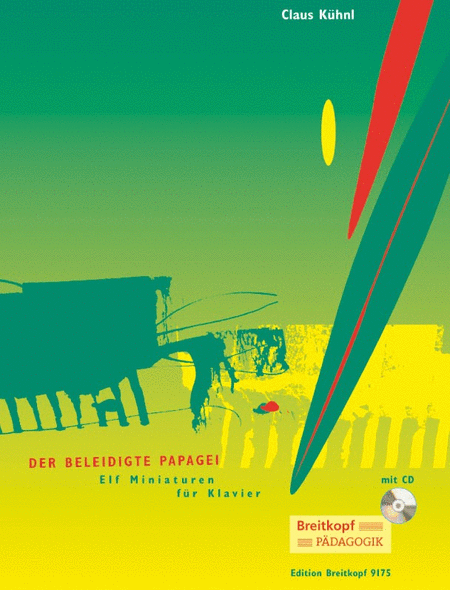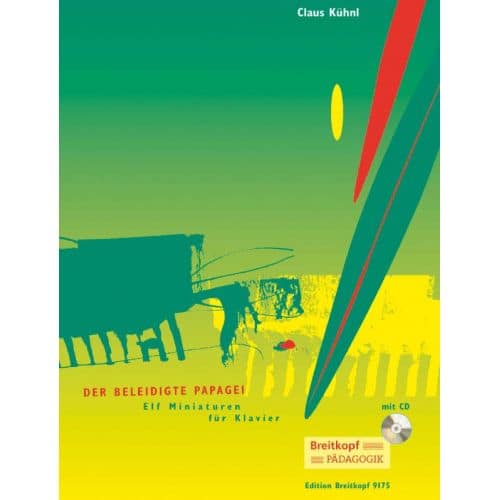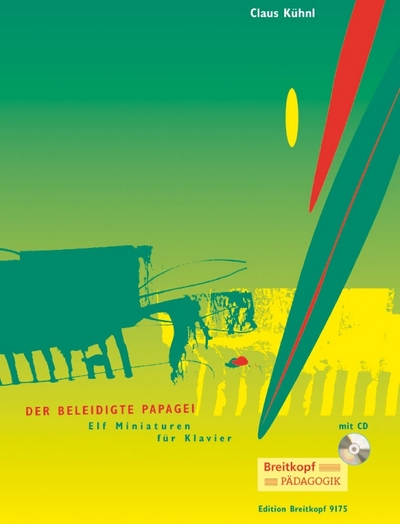 |  11 Miniaturen. Composed by
Claus Kuhnl. Edition
Breitkopf.
In these eleven short piano
pieces, the composer follows
the cue of such modern-day
masters as Olivier Messiaen,
Karlheinz Stockhausen, Helmut
Lachenmann and Nicolaus A.
Huber.
Pedagogical. Breitkopf and
Haertel #EB-9175. Published
by Breitkopf and Haertel Arr : Piano soloPublisher : Breitkopf & Härtel$28.95 - See more - Buy online

Sheet music extract
ISBN 979-0-004-18269-7. 9 x 12 in inches.
In these eleven short piano pieces, the composer follows the cue of such modern-day masters as Olivier Messiaen, Karlheinz Stockhausen, Helmut Lachenmann and Nicolaus A. Huber.
NEW! Free MP3 files of all pieces. Bridge to the masters of our time
In these eleven short piano pieces, the composer follows the cue of such modern-day masters as Olivier Messiaen, Karlheinz Stockhausen, Helmut Lachenmann and Nicolaus A. Huber. The miniatures are organized chiefly according to their level of difficulty. They are equally suited for piano lessons or recitals, either singly or as a collection. Whoever so wishes can hear the pieces before learning them thanks to an enclosed CD. The book also contains information on extra-musical references to every piece, as well as assignments for the students, background information, and texts that can be recited during the performance. We learn more about the "offended parrot," for instance, which goes back to Messiaen's modes and gave its name to the book. The "Three Chinamen...", in their turn, are not related to Lachenmann's "false, slightly inebriated" Chinamen from "Ein Kinderspiel" (EB 8275). They evoke the popular joking song and, with their double bass, are once again arrested by the police...
Bibliography:
Nimczik, Ortwin: Wie Klaviere auch klingen konnen. Den Klang von Klavieren neu entdecken mit Helmut Lachenmanns ?Guero? und Claus Kuhnls ?Klang und Stille?, in: Musik und Bildung 39 (2007). Heft 4, S. 64-68
is the journey or search for Simorgh a bird king. The journey ends when 30 birds have reached their goal (Simorgh). They then realize that it was an inward journey and search since each one of them carries his own Simorgh within him. At the same time the opera develops the theme of the search of the male beloved (Amado) for the female beloved (Amada) and his union with her - a union that is envisioned as both physical and mystical. The opera thematizes the dream of distant lands the journey and the dream of the search for God the beloved the bird king Simorgh and of an allencompassing love.
Press commentaries:
,, El viaje a Simorgh' unfolds very slowly and calmly above often sustained basses in richly proliferating sonorities that comprise electronically produced spatial effects as well as stylistic quotes. There can be no doubt about the composer's skill and craftsmanship or about his imaginativeness. (Peter Hagmann Neue Zurcher Zeitung)
,,Sanchez-Verdu has brilliantly transposed the images evoked by Goytisolo yet he also manages to disengage himself from them. (Hans-Gunter Kellner DeutschlandRadio)
,,The Teatro Real sharpens its own profile with the ambitious new production. (Eleonore Buning FAZ)
,,El viaje a Simorgh was commissioned by the Teatro Real which thus continues its successful tradition of fostering new works. The music and libretto are by one of Spain's leading composers Algeciras-born Jose M. Sanchez-Verdu. The stage production is the work of the high-profile visual artist Frederic Amat and the libretto is based on the novella ,,Las virtudes del pajaro solitario by Juan Goytisolo as well as on poems and texts by San Juan de la Cruz Ibn al Farid Fariduddin al-Attar ,,El cantar de los cantares (translated by Fray Luis de Leon) and Leonardo da Vinci.
In the words of the composer ,,El viaje a Simorgh (The Way to Simorgh) is based on a Sufi tale by Attar (Persia 12th century). It is the journey or search for Simorgh a bird king. The journey ends when 30 birds have reached their goal (Simorgh). They then realize that it was an inward journey and search since each one of them carries his own Simorgh within him. At the same time the opera develops the theme of the search of the male beloved (Amado) for the female beloved (Amada) and his union with her - a union that is envisioned as both physical and mystical. The opera thematizes the dream of distant lands the journey and the dream of the search for God the beloved the bird king Simorgh and of an all-encompassing love.
Photo (c) by Julian de Domingo
Bibliography:
Sanchez-Verdu Jose M.: ,,Lo peor que puede hacer un compositor es quedarse encerrado. Der Komponist im Gesprach mit Juan Antonio Llorente in: Doce Notas Heft 56 (April/Mai 2007) S. 8-11. |
|

 (AMERICAN COMPANY)
(AMERICAN COMPANY) 
 11 Miniaturen. Composed by
Claus Kuhnl. Edition
Breitkopf.
In these eleven short piano
pieces, the composer follows
the cue of such modern-day
masters as Olivier Messiaen,
Karlheinz Stockhausen, Helmut
Lachenmann and Nicolaus A.
Huber.
Pedagogical. Breitkopf and
Haertel #EB-9175. Published
by Breitkopf and Haertel
11 Miniaturen. Composed by
Claus Kuhnl. Edition
Breitkopf.
In these eleven short piano
pieces, the composer follows
the cue of such modern-day
masters as Olivier Messiaen,
Karlheinz Stockhausen, Helmut
Lachenmann and Nicolaus A.
Huber.
Pedagogical. Breitkopf and
Haertel #EB-9175. Published
by Breitkopf and Haertel


